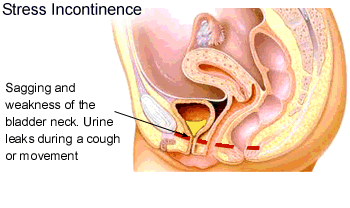


Low Pressure Fitness

Did you know that it is estimated that 1 in 3 women suffer from stress incontinence?
According to NAFC (National Association for Continence), over 25 million Americans are affected by incontinence - yet only about 1 out of every 12 people seek help! These statistics only account for those that have actually confirmed they 'leak'. It is speculated that over 50% of our women are suffering in silence from fear of embarrassment or just assuming that it is normal and accepting it without seeking treatment.
Recently, instead of looking for solutions, it seems our society has begun to normalize the fact that "leaking pee" or urinary incontinence is so prevalent. They try to make light of it, tell you it's ok & happens to everyone - or like this video... you're not working out hard enough if you're not peeing!
Whhhaatt??!!
Or what about this video? It pretty much sums it up.
Have a baby? Yep - you'll leak
Workout? Yep - leak away
Getting older? Yep - leakage!
Overweight? Yep - leak again
As the spokeswoman states, "The unexpected leak is every bit as natural as your period. It's not an age thing, it's a stage thing."
Notice, she does discuss the stress on the pelvic floor from everyday life. Their solution - buy our diapers!
My solution - Learn Low Pressure Fitness!
This video does a great job summing up the how's & why's of stress incontinence - and yes, kegels can be good for you. However, it is estimated that over 50% of women are doing them incorrectly.
If you are one of the ones with fabulous kegels - how are you maintaining the rest of your pelvic floor and core? Are they stable enough to withstand the increase in pressure from everyday living?
Again, it is so important to remember that incontinence can happen to anyone, and more women suffer from it than we realize. The answer is not diapers - or keigles on their own.
The answer is stabilizing the entire core and pelvic floor. Rehabilitating the resting tone and decreasing the intra-abdominal pressure so that your body can function the way it was originally designed.
If you have been working with a pelvic floor specialist, gynecologist or doctor - the only reason that Hypopressives, Low Pressure Fitness has not been addressed as an alternative, natural training is simply because
they probably don't know about it yet!
Being so new to the United States, it will take time for the general population and medical fields to become educated about the amazing benefits. Once they do - Low Pressure Fitness will be at the forefront of prevention and re-education of the pelvic floor.
Having weak pelvic floor muscles and tissue is one of the main problems associated with incontinence. In order to avoid problems, it is imperative to have a strong resting tone of the pelvic floor.
There are 5 main types of incontinence.
Stress Incontinence
-
Probably the most common form and is typically due
to a weak pelvic floor.
-
Increased pressure on your bladder from things such as
exercising, coughing, laughing and sneezing can cause
small amounts of urine to leak.
-
Pregnancy, childbirth or being overweight can stretch and
weaken a woman's pelvic floor.
Urge Incontinence (AKA Over Active Bladder)
-
Defined by a sudden need to go to the restroom and you may or may not get there in time.
-
Can be a small or large loss of urine.
-
Can be caused by damage to the bladder nerves, overstimulation of other parts of the nervous system, or weak or tight pelvic floor muscles.
-
Anxiety or depression could worsen the effects/symptoms of Urge Incontinence.
Overflow Incontinence
-
Defined by the inability to completely empty the bladder which can result in a dribbling of urine.
-
Causes can be from weak pelvic floor muscles, nerve damage, constipation, conditions that block the flow of urine such as a tumor or enlarged prostate in men, or even certain medications.
Functional Incontinence
-
Defined by having a physical or mental problem associated with making it to the restroom in time. For example, dementia or a broken hip not allowing you to move to the restroom on your own.
-
Occupational therapists can be a great asset for this particular type of incontinence.
Mixed Urinary Incontinence
-
This is defined by having two or more of the above types of incontinence. The most common coupling for women is stress incontinence and urge incontinence.


